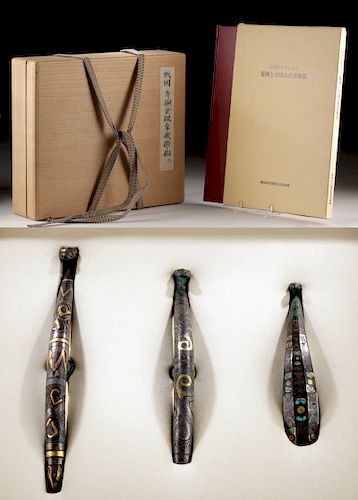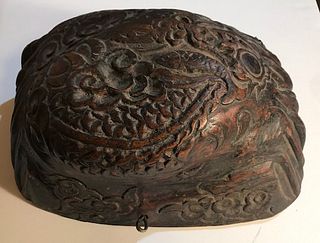Lot of 3 Chinese Silver, Gold, & Bronze Belt Hooks
Lot 134a
About Seller
Artemis Gallery
686 S Taylor Ave, Ste 106
Louisville, CO 80027
United States
Selling antiquities, ancient and ethnographic art online since 1993, Artemis Gallery specializes in Classical Antiquities (Egyptian, Greek, Roman, Near Eastern), Asian, Pre-Columbian, African / Tribal / Oceanographic art. Our extensive inventory includes pottery, stone, metal, wood, glass and textil...Read more
Categories
Estimate:
$18,000 - $24,000
Absentee vs Live bid
Two ways to bid:
- Leave a max absentee bid and the platform will bid on your behalf up to your maximum bid during the live auction.
- Bid live during the auction and your bids will be submitted real-time to the auctioneer.
Bid Increments
| Price | Bid Increment |
|---|---|
| $0 | $25 |
| $300 | $50 |
| $1,000 | $100 |
| $2,000 | $250 |
| $5,000 | $500 |
| $10,000 | $1,000 |
| $20,000 | $2,500 |
| $50,000 | $5,000 |
| $100,000 | $10,000 |
| $200,000 | $20,000 |
About Auction
By Artemis Gallery
Sep 26, 2019
Set Reminder
2019-09-26 10:00:00
2019-09-26 10:00:00
America/New_York
Bidsquare
Bidsquare : Exceptional Day 1: Antiquities & Asian Art
https://www.bidsquare.com/auctions/artemis-gallery/exceptional-day-1-antiquities-asian-art-4437
Day 1 of an important 2-day auction featuring exceptional, museum-worthy examples of Egyptian, Greek, Etruscan, Roman, Viking, Russian, Near Eastern, as well as Asian Art from China, Japan, Thailand, Vietnam, Burma and India. Artemis Gallery info@artemisgallery.com
Day 1 of an important 2-day auction featuring exceptional, museum-worthy examples of Egyptian, Greek, Etruscan, Roman, Viking, Russian, Near Eastern, as well as Asian Art from China, Japan, Thailand, Vietnam, Burma and India. Artemis Gallery info@artemisgallery.com
- Lot Description
East Asia, China, Warring States Period, ca. 475 to 221 BCE. A trio of magnificent slender belt hooks terminating in a modeled animal head. All are made of bronze with inlaid silver and gold; the smallest also has inlaid turquoise in beautiful accents to the motifs. These are stylized swirls, and other geometric forms that resemble the leiwen of earlier Chinese artwork - symbols of clouds and thunderheads. Each hook has a slender, backwardly curving form with a raised button on its back for attachment. At its narrow end is a curved hook in the form of a horse or other animal's head. All three are contained inside a custom bamboo box and a book (title below) accompanies the purchase. Size of largest: 0.65" W x 7.05" H (1.7 cm x 17.9 cm); size of custom box: 3" L x 11.6" W x 7.05" H (7.6 cm x 29.5 cm x 17.9 cm)
Chinese men used belt ornaments to wear tight trousers, necessary for riding horses. Warring States period texts state that the tradition of belt hooks came from Central Asia, which was also the origin of the equestrian tradition in China, and so belt hooks were initially a symbol of exoticism and foreignness. This exoticism gave them an air of the erotic, and Qu Yuan (ca. 340 to 278 BCE), a Chinese poet and minister, compared the shape of beautiful women to belt hooks like these.
A book written in Japanese accompanies this purchase: Egawa Collection, "Belt Hooks & Ancient Chinese Bronzes" from the Kuboso Memorial Museum of Arts, Izumi, 2001.
Provenance: private Canada collection; ex-Yanai Gallery, Tokyo, Japan aquired in 2007; ex-Mr. Hiro Kawabe collection, Tokyo, Japan
All items legal to buy/sell under U.S. Statute covering cultural patrimony Code 2600, CHAPTER 14, and are guaranteed to be as described or your money back.
A Certificate of Authenticity will accompany all winning bids.
We ship worldwide and handle all shipping in-house for your convenience.
#149294Rich patina on all. Some small losses to the gold, silver, and turquoise, but overall these are in beautiful condition.Condition
- Shipping Info
-
All shipping is handled in-house for your convenience. Your invoice from Artemis Gallery will include shipping calculation instructions. If in doubt, please inquire BEFORE bidding for estimated shipping costs for individual items.
-
- Buyer's Premium



 EUR
EUR CAD
CAD AUD
AUD GBP
GBP MXN
MXN HKD
HKD CNY
CNY MYR
MYR SEK
SEK SGD
SGD CHF
CHF THB
THB

















